Before beginning my extended 10 week practicum, a big question came to my mind about implementing creativity; is the implementation of creative and inquiry based learning going to be as easy as it sounds? The answer, as I have discovered, is no. There is so much that goes into providing students with hands on, experiential lessons. There are teachers out there who are able to provide this type of learning, and my question to them is, when is the last time you slept? I have tried to make my lessons fun and engaging for my students by using a variety of activities, modes of learning – kinaesthetic, auditory, written, exploratory, and I have to say, planning one lesson with exploration and experimentation in mind is tough. Hours of preparation go into these lessons. Now, I am not sure if this is because I am still brand new, or if it is always like this, but one thing I have discovered, with the help of my school advisors, is balance. Balance is a key factor to doing anything well. As much fun as our students have with hands on learning, doing the occasional worksheet is not a terrible thing! I have learned that in order to give my all, I needed to take a step back and realize that it is better to do fewer grand activities that are meaningful, rather than trying to do too much just for the sake of it.
I recently taught a science unit on light and sound, my first big theme of my practicum. I worked very hard at making my lessons fun, and experiential, but my main focus was – “is it meaningful?”. One particular day, a few students answered this question for me; a parent of one of my students came in and, looking at our inquiry “Wonder Wall” said that “this was the first topic her child had been excited about in a long time”. What? Are you serious? I thought my day had been made right then and there, my heart was glowing and I was so excited that I have engaged a student in a topic enough that they wanted to go home and tell their parents about their learning! Yes!! But my joy didn’t end there, later in the morning, another student was being taken out by their parent for an appointment, this student said to their parent “I need to be back this afternoon for Ms.Oreziak’s science lesson”. Just try to stop me from smiling from ear to ear after a comment like that! Other little comments popped up as well throughout the weeks, “are we doing science today Ms. Oreziak?” followed by groans if the answer was no and cheers if the answer was yes. The moral of why I am writing about this, is that no matter what, when you make a lesson and topic engaging and meaningful, students will understand that learning is actually fun, it is not simply “work”. Teachers need to work at engaging their students in a variety of ways. Routines get boring, it’s important to change things up, especially in the third term.
Moving forward, I need to maintain balance in my lessons. I am still a big advocate for promoting creativity and inquiry into the teaching and learning process, I think it is paramount to student engagement. Something that I have found to be a real challenge in implementing inquiry based learning is that it is easier to do when students can be independent. By this I mean, they are able to read, reflect, and research on their own. As a TC with a class of kindergarten and grade one students, my goal has become – teach students HOW to ask questions. My mentality going into inquiry was – come up with a question and explore it. Explore it how? If students come up with a big, overarching question, that is fantastic. Teachers can use that question to guide their teaching and help to create a theme within a unit. That way, we can explore the question within our lessons, as a class. Students that are 5,6 and 7 years old are not (for the most part) able to independently explore their questions in a formal manner.
I can feel myself questioning my practice on a daily basis, after some experience, I am curious to see how my inquiry topic evolves.

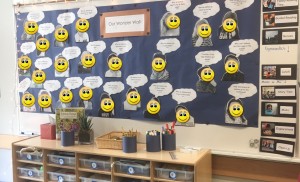 motion of inquiry based learning. In the primary years, classrooms would have “wonder walls” and in the middle years common areas there would be students’ bodies outlined with questions written inside. Having these questions visible at all times reminds students of their curiosities and promotes exploration, again, independently or as a group.
motion of inquiry based learning. In the primary years, classrooms would have “wonder walls” and in the middle years common areas there would be students’ bodies outlined with questions written inside. Having these questions visible at all times reminds students of their curiosities and promotes exploration, again, independently or as a group.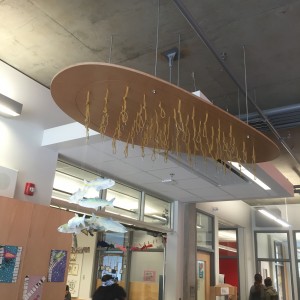 displayed and I can only imagine that it gives the students a sense of pride to have their work shown off for the school to see. Even though there may be lots of obvious themes throughout the school, it becomes clear that students are able to use their own creative licenses. Art supplies, books and play based objects were easily accessible at all times, allowing students to ex
displayed and I can only imagine that it gives the students a sense of pride to have their work shown off for the school to see. Even though there may be lots of obvious themes throughout the school, it becomes clear that students are able to use their own creative licenses. Art supplies, books and play based objects were easily accessible at all times, allowing students to ex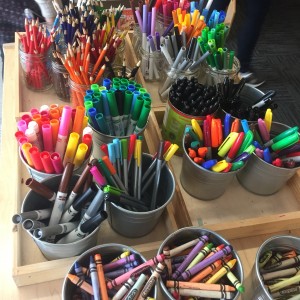
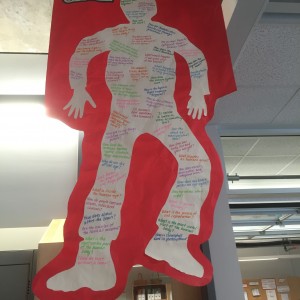
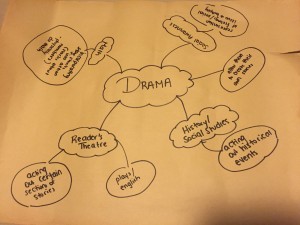
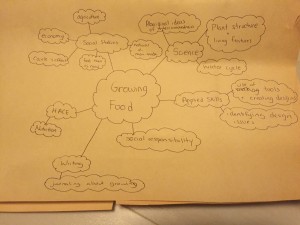 up with some great cross-curricular ideas for how to implement each topic. The purpose of this exercise was to show that it is possible to incorporate the interests of our students into our teaching topics while still meeting expectations set by the ministry.
up with some great cross-curricular ideas for how to implement each topic. The purpose of this exercise was to show that it is possible to incorporate the interests of our students into our teaching topics while still meeting expectations set by the ministry.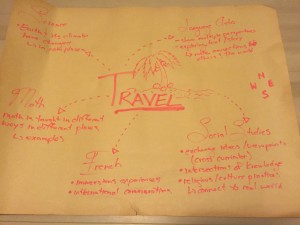 For this workshop I think that I expressed my objectives and expectations clearly and the group was receptive to my activities. I wanted to make the workshop as hands on as I could since I am encouraging creative thinking. I think that I managed my time well and allocated enough time to each activity. I did not get the feeling that people felt rushed during their Think Pair Share, I think we were able to hear from a large number of people who wanted to share. As I mentioned, I wish I had more time to get into the topics and curriculum activity, but I think that the 15 minutes allocated was enough for everyone to get a sense of the possibilities. I also decided to use a survey created on surveynuts.com and I used Prezi to create a visual presentation, I had never used either of these tools before, and wanted to challenge myself by exploring new tools. I think they both worked well and that my message was received by the participants. Something else I have been working on is my teacher to student talk ratio, I wanted to give the group more time for peer to peer discussion rather than hear me give another presentation on my inquiry topic. I am overall very pleased with how my workshop unfolded, the only critique I have is that I perhaps should have selected either the Think Pair Share OR the topics and curriculum activity to focus on. This may have allowed us to gather some deeper meanings and opinions, however, I think they worked well together and provided some good pre-thinking time and activity time.
For this workshop I think that I expressed my objectives and expectations clearly and the group was receptive to my activities. I wanted to make the workshop as hands on as I could since I am encouraging creative thinking. I think that I managed my time well and allocated enough time to each activity. I did not get the feeling that people felt rushed during their Think Pair Share, I think we were able to hear from a large number of people who wanted to share. As I mentioned, I wish I had more time to get into the topics and curriculum activity, but I think that the 15 minutes allocated was enough for everyone to get a sense of the possibilities. I also decided to use a survey created on surveynuts.com and I used Prezi to create a visual presentation, I had never used either of these tools before, and wanted to challenge myself by exploring new tools. I think they both worked well and that my message was received by the participants. Something else I have been working on is my teacher to student talk ratio, I wanted to give the group more time for peer to peer discussion rather than hear me give another presentation on my inquiry topic. I am overall very pleased with how my workshop unfolded, the only critique I have is that I perhaps should have selected either the Think Pair Share OR the topics and curriculum activity to focus on. This may have allowed us to gather some deeper meanings and opinions, however, I think they worked well together and provided some good pre-thinking time and activity time. What do we think about when we imagine a classroom the promotes creative thinking? Providing an environment where students are free to think, problem solve and create can be difficult for teachers to accomplish. Many teachers are accustomed to the “traditional” classroom, one where students work at there desks, whiteboard up front and scheduled times for exploration and play. We need to provide our students with an environment where they can learn in a way that best suits them. How do we do this? Something that I think is important to be excited about what our students are interested in, in order for them to persue a topic they will still need us as their guide. We are still required to assess their learning, and assist them when they struggle. It is not necessary for us to be experts in every topic just in case a student has a particular interest. We do need to be willing to join them on their learning journey and show them that we are excited about the process. This will show them that regardless of the outcome of a project, learning is still taking place, students will build resiliance and perhaps strengthen their interest of a topic.
What do we think about when we imagine a classroom the promotes creative thinking? Providing an environment where students are free to think, problem solve and create can be difficult for teachers to accomplish. Many teachers are accustomed to the “traditional” classroom, one where students work at there desks, whiteboard up front and scheduled times for exploration and play. We need to provide our students with an environment where they can learn in a way that best suits them. How do we do this? Something that I think is important to be excited about what our students are interested in, in order for them to persue a topic they will still need us as their guide. We are still required to assess their learning, and assist them when they struggle. It is not necessary for us to be experts in every topic just in case a student has a particular interest. We do need to be willing to join them on their learning journey and show them that we are excited about the process. This will show them that regardless of the outcome of a project, learning is still taking place, students will build resiliance and perhaps strengthen their interest of a topic.